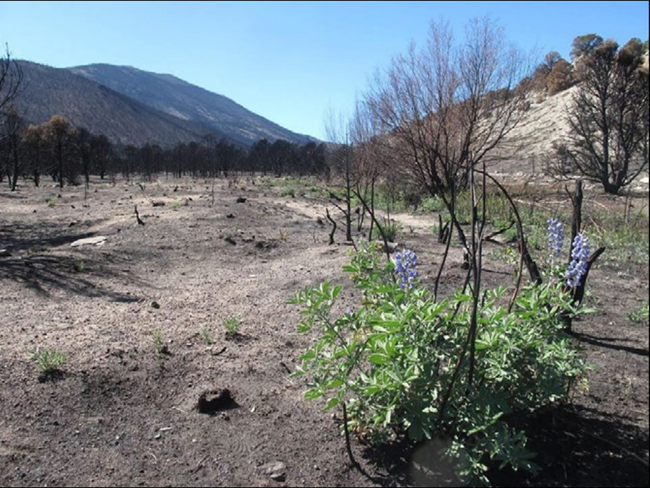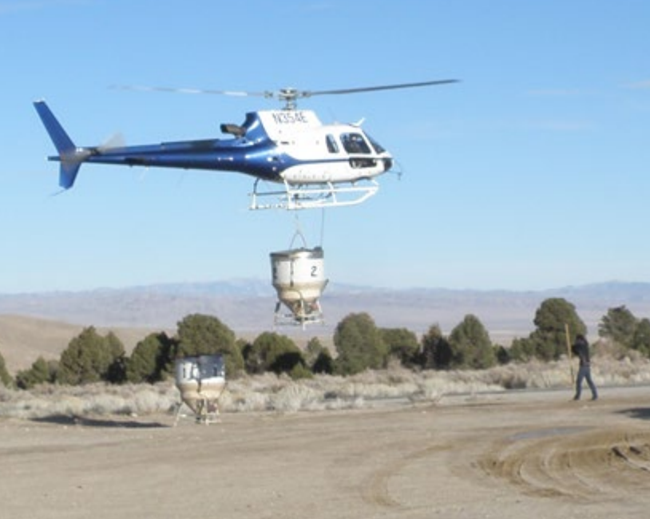Part of a series of articles titled The Midden - Great Basin National Park: Vol. 17, No. 1, Summer 2017.
Article
Strawberry Fire Burned Area Rehabilitation and Restoration
This article was originally published in The Midden – Great Basin National Park: Vol. 17, No. 1, Summer 2017.

Photo by Brian Flynn
The lightning-ignited Strawberry Fire was reported on August 8, 2016 in upper Strawberry Creek in Great Basin National Park. Aided by strong winds, the fire quickly grew, burning a large portion of the canyon and pushing the fire down-canyon onto BLM and private lands. The fire was declared controlled on August 23, 2016 after 4,656 acres burned, with 2,790 acres on NPS and 1,769 acres on Bureau of Land Management lands. The fire consumed a mix of habitat types. The dominant plant communities impacted in the park were montane sagebrush steppe (1,148 acres), pinyon-juniper (667 acres), aspen (597 acres), mountain mahogany (209 acres) and montane riparian (42 acres).
After the fire, resource management staff prepared a Burned Area Rehabilitation (BAR) plan to address and mitigate natural resource issues created or exacerbated by the fire. Plan objectives were 1) prevent the establishment of non-native invasive plants to enable the restoration and establishment of a healthy, stable ecosystem 2) revegetate lands unlikely to recover naturally post-fire and 3) replace minor infrastructure destroyed by the fire.
The park selected several strategies to meet BAR plan objectives for native vegetation recovery including aerial seeding and invasive plant management. Preventing the establishment of invasive forbs and annual grasses, mainly cheatgrass (Bromus tectorum), following fire is critical to protect and maintain healthy, resilient plant communities. Cheatgrass invades recently burned sites, particularly pinyon-juniper woodlands and sagebrush-steppe, and can maintain dominance for decades. Not only does this compromise native plant recovery, but it also adversely affects soil stabilization and fire return intervals. Non-native invasive forbs such as bull thistle (Cirsium vulgare), spotted knapweed (Centaurea stoebe), and whitetop (Cardaria draba) exploit soil and vegetation disturbances following wildfires and fire suppression activities. They can then outcompete native vegetation for limited resources, negatively affect soils and discourage use by wildlife. A total of 894 acres in the park were determined to be at-risk of invasion and recommended for aerial seeding.

NPS Photo by Julie Long

NPS Photo by Margaret Horner
Restoration and monitoring will continue for the next several years. Additional seeding efforts may be needed depending on establishment success and persistence of native plants seeded this winter. In arid regions, precipitation is highly variable, causing uncertainty and high failure rates in germination and seedling establishment. Recent reviews of the factors limiting seeding success have recommended a “bet hedging” strategy (Madsen et al. 2016). Rather than applying seed at high rates during a single fall seeding, seed is applied at lower rates, with multiple seedings at varying times of year. With multiple seedings, native species have more opportunity to utilize soil moisture conditions maximizing the probability of establishment.

NPS Photo by Bryan Hamilton
Literature Cited:
Madsen M.D., K.W. Davies, C.S. Boyd, J.D. Kerby, and T.J. Svejcar. 2016. Emerging seed enhancement technologies for overcoming barriers to restoration. Restoration Ecology, 24:S77-S84. doi:10.1111/rec.12332
Last updated: March 7, 2024
